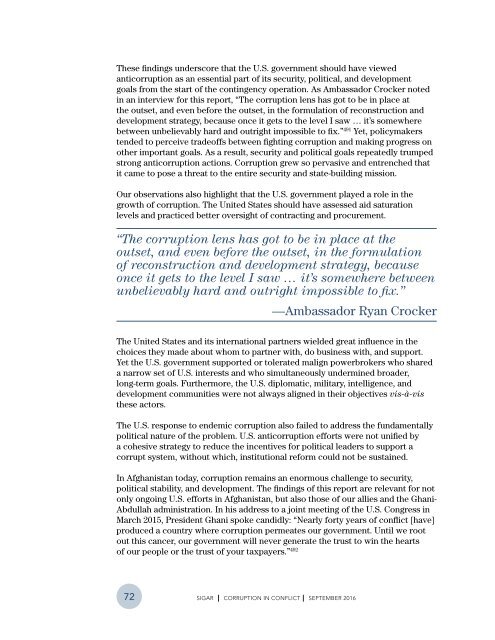CORRUPTION IN CONFLICT
5IlaWjQej
5IlaWjQej
You also want an ePaper? Increase the reach of your titles
YUMPU automatically turns print PDFs into web optimized ePapers that Google loves.
These findings underscore that the U.S. government should have viewed<br />
anticorruption as an essential part of its security, political, and development<br />
goals from the start of the contingency operation. As Ambassador Crocker noted<br />
in an interview for this report, “The corruption lens has got to be in place at<br />
the outset, and even before the outset, in the formulation of reconstruction and<br />
development strategy, because once it gets to the level I saw … it’s somewhere<br />
between unbelievably hard and outright impossible to fix.” 491 Yet, policymakers<br />
tended to perceive tradeoffs between fighting corruption and making progress on<br />
other important goals. As a result, security and political goals repeatedly trumped<br />
strong anticorruption actions. Corruption grew so pervasive and entrenched that<br />
it came to pose a threat to the entire security and state-building mission.<br />
Our observations also highlight that the U.S. government played a role in the<br />
growth of corruption. The United States should have assessed aid saturation<br />
levels and practiced better oversight of contracting and procurement.<br />
“The corruption lens has got to be in place at the<br />
outset, and even before the outset, in the formulation<br />
of reconstruction and development strategy, because<br />
once it gets to the level I saw … it’s somewhere between<br />
unbelievably hard and outright impossible to fix.”<br />
—Ambassador Ryan Crocker<br />
The United States and its international partners wielded great influence in the<br />
choices they made about whom to partner with, do business with, and support.<br />
Yet the U.S. government supported or tolerated malign powerbrokers who shared<br />
a narrow set of U.S. interests and who simultaneously undermined broader,<br />
long-term goals. Furthermore, the U.S. diplomatic, military, intelligence, and<br />
development communities were not always aligned in their objectives vis-à-vis<br />
these actors.<br />
The U.S. response to endemic corruption also failed to address the fundamentally<br />
political nature of the problem. U.S. anticorruption efforts were not unified by<br />
a cohesive strategy to reduce the incentives for political leaders to support a<br />
corrupt system, without which, institutional reform could not be sustained.<br />
In Afghanistan today, corruption remains an enormous challenge to security,<br />
political stability, and development. The findings of this report are relevant for not<br />
only ongoing U.S. efforts in Afghanistan, but also those of our allies and the Ghani-<br />
Abdullah administration. In his address to a joint meeting of the U.S. Congress in<br />
March 2015, President Ghani spoke candidly: “Nearly forty years of conflict [have]<br />
produced a country where corruption permeates our government. Until we root<br />
out this cancer, our government will never generate the trust to win the hearts<br />
of our people or the trust of your taxpayers.” 492<br />
72<br />
SIGAR I <strong>CORRUPTION</strong> <strong>IN</strong> <strong>CONFLICT</strong> I SEPTEMBER 2016


